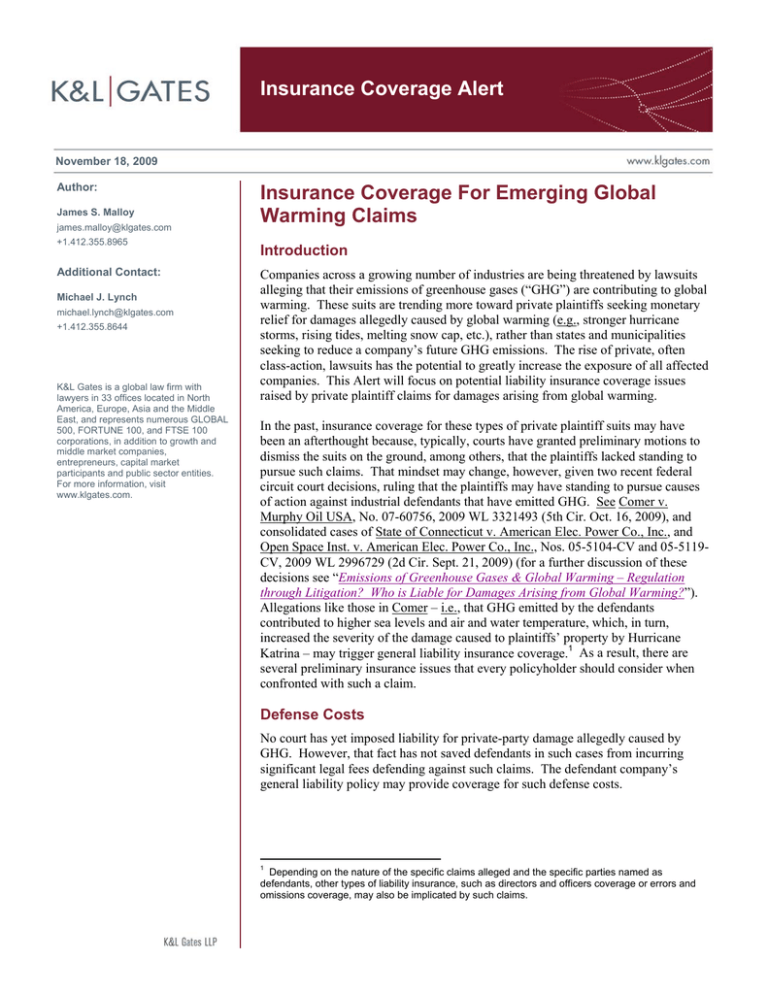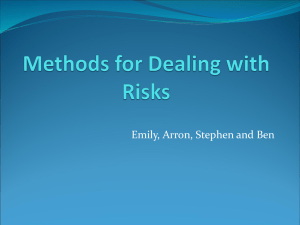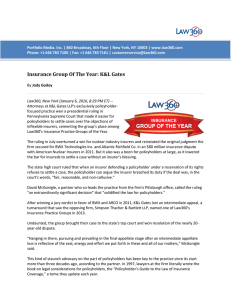
Insurance Coverage Alert
November 18, 2009
Author:
James S. Malloy
james.malloy@klgates.com
+1.412.355.8965
Additional Contact:
Michael J. Lynch
michael.lynch@klgates.com
+1.412.355.8644
K&L Gates is a global law firm with
lawyers in 33 offices located in North
America, Europe, Asia and the Middle
East, and represents numerous GLOBAL
500, FORTUNE 100, and FTSE 100
corporations, in addition to growth and
middle market companies,
entrepreneurs, capital market
participants and public sector entities.
For more information, visit
www.klgates.com.
Insurance Coverage For Emerging Global
Warming Claims
Introduction
Companies across a growing number of industries are being threatened by lawsuits
alleging that their emissions of greenhouse gases (“GHG”) are contributing to global
warming. These suits are trending more toward private plaintiffs seeking monetary
relief for damages allegedly caused by global warming (e.g., stronger hurricane
storms, rising tides, melting snow cap, etc.), rather than states and municipalities
seeking to reduce a company’s future GHG emissions. The rise of private, often
class-action, lawsuits has the potential to greatly increase the exposure of all affected
companies. This Alert will focus on potential liability insurance coverage issues
raised by private plaintiff claims for damages arising from global warming.
In the past, insurance coverage for these types of private plaintiff suits may have
been an afterthought because, typically, courts have granted preliminary motions to
dismiss the suits on the ground, among others, that the plaintiffs lacked standing to
pursue such claims. That mindset may change, however, given two recent federal
circuit court decisions, ruling that the plaintiffs may have standing to pursue causes
of action against industrial defendants that have emitted GHG. See Comer v.
Murphy Oil USA, No. 07-60756, 2009 WL 3321493 (5th Cir. Oct. 16, 2009), and
consolidated cases of State of Connecticut v. American Elec. Power Co., Inc., and
Open Space Inst. v. American Elec. Power Co., Inc., Nos. 05-5104-CV and 05-5119CV, 2009 WL 2996729 (2d Cir. Sept. 21, 2009) (for a further discussion of these
decisions see “Emissions of Greenhouse Gases & Global Warming – Regulation
through Litigation? Who is Liable for Damages Arising from Global Warming?”).
Allegations like those in Comer – i.e., that GHG emitted by the defendants
contributed to higher sea levels and air and water temperature, which, in turn,
increased the severity of the damage caused to plaintiffs’ property by Hurricane
Katrina – may trigger general liability insurance coverage.1 As a result, there are
several preliminary insurance issues that every policyholder should consider when
confronted with such a claim.
Defense Costs
No court has yet imposed liability for private-party damage allegedly caused by
GHG. However, that fact has not saved defendants in such cases from incurring
significant legal fees defending against such claims. The defendant company’s
general liability policy may provide coverage for such defense costs.
1
Depending on the nature of the specific claims alleged and the specific parties named as
defendants, other types of liability insurance, such as directors and officers coverage or errors and
omissions coverage, may also be implicated by such claims.
Insurance Coverage Alert
Specifically, primary liability policies often impose
on the insurer a duty to defend the policyholder from
any claims that may arguably fall within the terms of
the insurance policy.2 It is generally recognized that
an insurer’s duty to defend is broader than its duty to
indemnify. Thus, an insurer may be required to
defend an action for which it ultimately may not be
required to indemnify the insured.
In the case of global warming claims, an insurer
would be obligated to provide a defense to the
policyholder so long as the allegations of the
plaintiff’s claim, if proven, would be within the
coverage provided by the insurer. In cases like
Comer, the basic allegations that the policyholder’s
actions caused property damage to the plaintiff may
be sufficient to trigger the insurer’s duty to defend.
It does not matter that liability may not ultimately be
imposed on the policyholder or that the insurer may
raise a successful defense to coverage. Until such
time as the insurer proves that the entire claim is
excluded from coverage, the insurer typically must
provide a defense to the policyholder. Thus, a
liability policy’s defense duty may provide coverage
for all or at least a significant portion of a
company’s defense costs, including expert fees,
incurred in defending global warming claims.
A policyholder should consider providing notice
under any and every policy that may be triggered by
the lawsuit based on the factual allegations
presented (e.g., time period of the alleged injury or
damage at issue) and the amount of potential
damages sought (e.g., does the amount of potential
damages exceed the limits of the policyholder’s
primary policy?). To determine which particular
insurance policies may potentially provide coverage
for a claim, both the current liability insurance
program, including excess coverage, as well as
historical policies should be reviewed. Many
historical general liability policies were written on
an “occurrence” basis and could provide coverage if
the plaintiff’s claim alleges property damage having
taken place during a long-since-expired policy
period, regardless of when the claim is subsequently
asserted. For example, if a plaintiff alleges that the
policyholder’s emission of GHG has been causing
property damage since 1965, the policyholder has
an argument for accessing coverage from every
liability policy providing coverage since that year.
As such, it is important for a policyholder to
conduct a detailed review of the allegations in the
complaint to make sure that any potential insurers
are put on notice of the claim, regardless of whether
the policy is ultimately called upon to indemnify the
policyholder.
Tendering a Claim to the Insurer
To ensure that the policyholder’s right to a defense
and indemnity is preserved, the policyholder must
give notice of the claim to its insurer(s). Most
policies have specific procedures and conditions for
reporting a claim (e.g., that the notice be in writing)
and some of these provisions may incorporate time
deadlines and other specific requirements. Insurers
will argue that failure to strictly comply with these
procedural requirements for notice precludes
coverage for an otherwise covered claim. Thus, a
policyholder must be mindful of all of the provisions
and conditions in their policies, including the
policyholder’s duty to provide timely notice and to
cooperate with the insurer in the defense of the
action.
Possible Insurer Defenses to
Coverage
Insurance companies can be expected to raise a
number of defenses to coverage for claims related to
global warming, including:
Lack of Fortuity – Insurers frequently contend that
insurance policies have an express or implied
concept of fortuity, i.e., the policy insures only
chance occurrences or events. Insurer-side
commentators have already argued that a
policyholder’s emission of GHG may not be a
fortuitous occurrence since companies have long
known they were emitting GHG and nonetheless
continued to do so.3 An insurer’s fortuity argument
could come in several forms, including arguing:
3
2
Similarly, umbrella and excess policies often impose on the
insurer a duty to reimburse the policyholder for its legal fees
and costs in defending a claim.
See The Costs of Climate Change: Why Industry Should
Not Look to Liability Insurance to Bear Them, Seth A. Ribner
and Deborah L. Stein, Committee on Insurance Coverage
Litigation Vol. 17, No. 7 September/October 2007.
November 18, 2009
2
Insurance Coverage Alert
(i) that there is no “occurrence” under the policy
language because the alleged damage was not the
result of an accident, but rather was caused by its
deliberate actions; or (ii) that the damage done by
the GHG was expected or intended by the
policyholder; or (iii) the damage done by the GHG
was a known loss to the policyholder at the time that
the policy was purchased.
The policyholder has potentially successful
responses to these defenses. In many jurisdictions,
the critical issue is not whether the policyholder
expected or intended the action giving rise to the
alleged damage, but rather whether the policyholder
expected or intended the resulting damage. In those
jurisdictions, a policyholder may be able to
overcome an insurer’s “lack-of-accident” and
“expected-or-intended” defenses if it did not expect
or intend that its emissions were causing the alleged
damage or injury for which it has been sued.
Similarly, the policyholder may be able to overcome
an insurer’s “known loss” defense if it was unaware
of the alleged injury at the time that it purchased the
policy.
Timing of Damage – Many commercial liability
policies in effect currently are written on a “claimsmade” basis, meaning that they provide coverage if
the claim is made against the policyholder during the
time period covered by the policy. Therefore, a
policyholder that is sued for alleged injury arising
from GHG emissions may seek coverage under the
claims-made policy on the risk when the claim is
asserted against the policyholder, even if the alleged
damage pre-dated the policy period.
Depending on the allegations of the complaint and
the facts, the policyholder may also be able to obtain
coverage from its current and/or historical
“occurrence”-based liability policies. Under such
policies, a claim may be covered if some part of the
alleged property damage or bodily injury occurs
during the policy period, regardless of when the
claim is asserted. Thus, if the plaintiff alleges that
the GHG emissions have caused property damage
over the last thirty years, the policyholder may be
able to seek coverage from every occurrence policy
on the risk from the late 1970s through the date of
the last such policy. Of course, in the absence of an
allegation of property damage taking place during
previous policy periods, it will be difficult to obtain
a defense from those historical policies.
Pollution Exclusion – Prior to 1970, most general
liability policies did not contain any provision
purporting to exclude coverage for damage
allegedly caused by pollution. Beginning around
1970, many liability policies included what has been
called the “qualified pollution exclusion.” Although
the language of these exclusions varied to some
degree, they essentially purported to preclude
coverage for property damage or bodily injury
allegedly resulting from pollution, unless the
pollution was “sudden and accidental” or “sudden,
unexpected and unintended.” Beginning around the
mid-1980s, most insurers began including an
“absolute pollution exclusion” in their policies,
which purports to exclude coverage for any liability
arising from pollution-caused damage, regardless of
whether the pollution incident was sudden and
accidental.
Policyholders who are sued in GHG emission cases
will need to determine whether their liability
policies that may otherwise provide coverage
contain a pollution exclusion and, if so, the
particular type of exclusion. If the policies at issue
contain any type of pollution exclusion, the insurers
for those policies will likely argue that they bar
coverage. However, policyholders have reasonable
arguments in response.
The most basic issue regarding a pollution
exclusion’s application is whether GHG and carbon
dioxide are “pollutants” under the definitions in the
policies. In this regard, insurers may point to the
decision in Massachusetts v. Environmental
Protection Agency, 549 U.S. 497 (2007), wherein
the Supreme Court of the United States held that
carbon dioxide emissions were a pollutant under the
Clean Air Act. That ruling, however, is not
dispositive of the issue. First, the Massachusetts
decision had nothing to do with the application of
the pollution exclusion in a liability policy, but
instead was focused on the EPA’s ability to regulate
GHG. Second, most insurance policies define
“pollutant” more narrowly than the Clean Air Act.
As the Court in Massachusetts stated, “[t]he Clean
Air Act’s sweeping definition of ‘air pollutant’
includes ‘any air pollution agent or combination of
such agents, including any physical, chemical …
November 18, 2009
3
Insurance Coverage Alert
substance or matter which is emitted into or
otherwise enters the ambient air ….’ On its face, the
definition embraces all airborne compounds of
whatever stripe, and underscores that intent through
the repeated use of the word ‘any.’” Id. at 528-29
(emphasis in original). Insurance policies, by
contrast, generally define “pollutants” as “any solid,
liquid, gaseous or thermal irritant or contaminant,
including smoke, vapor, soot, fumes, acids, alkalis,
chemicals and waste.” Thus, for insurance purposes,
a “pollutant” must be an irritant or contaminant.
Carbon dioxide arguably falls outside those
categories; further, it cannot be neatly classified into
any of the specified forms of pollutants in the
definition, either.4
If a policyholder is seeking coverage under a policy
that has a qualified pollution exclusion, it may be
able to avoid the exclusion if it can establish that the
alleged contamination of the environment was
“sudden and accidental.” Various jurisdictions have
interpreted this phrase differently. Although many
courts have agreed that the word “accidental” means
“unintended,” courts disagree regarding the proper
meaning of the word “sudden.” Some courts have
ruled that it means “instantaneous.” Thus, under this
interpretation, the policyholder can only avoid the
qualified pollution exclusion if it can prove that the
contamination occurred abruptly, and not gradually.
A policyholder confronting the typical GHG
emission claim may find it difficult to satisfy this
requirement. Nonetheless, many other courts have
interpreted “sudden” to mean “unexpected.” Under
this view, a policyholder may be able to obtain
coverage notwithstanding the qualified pollution
exclusion if it can establish that it did not expect or
intend the alleged contamination of the environment
arising from its GHG emissions.
Finally, there are other arguments policyholders may
assert against the application of the pollution
exclusion. For example, some courts have
interpreted the pollution exclusion not to apply to
product liability hazards because such hazards were
not intended to be the subject of the exclusion.
Likewise, some commentators have argued that the
pollution exclusion would not apply to global
warming liabilities because the reasonable
4
Moreover, most jurisdictions interpret any ambiguity in
insurance policy language in favor of coverage.
expectations of the policyholder in procuring
liability coverage would be that such claims are not
excluded.5
Conclusion
As the above discussion makes clear: (i) insurers are
likely to challenge claims for coverage for GHG
emissions claims; (ii) they will seek to rely on
certain provisions of their policies in asserting
defenses to coverage; (iii) policyholders may have
effective arguments in response to the insurers’
defenses regarding such claims; (iv) the allegations
of the complaint, the actual facts, and the specific
language of the policies at issue will be critical in
the determination whether coverage is available;
and (v) different jurisdictions interpret key policy
language differently, and the choice-of-law
determination in the coverage dispute may be
critical.
Whether the recent Comer and American Electric
Power decisions will open the floodgates of global
warming litigation as many commentators predict
remains to be seen. What is known, though, is that
companies that are named defendants in these
lawsuits may be able to look to their general
liability policies to respond to such claims and
provide some protection.
5
See Managing the Risk of Global Warming: Avoiding the
Mass Tort Template and Insurance Coverage Implications,
James M. Davis and Noel C. Paul, Committee on Insurance
Coverage Litigation Vol. 17, No. 5 May/June 2007.
November 18, 2009
4
Insurance Coverage Alert
Anchorage Austin Beijing Berlin Boston Charlotte Chicago Dallas Dubai Fort Worth Frankfurt Harrisburg Hong Kong London
Los Angeles Miami Newark New York Orange County Palo Alto Paris Pittsburgh Portland Raleigh Research Triangle Park
San Diego San Francisco Seattle Shanghai Singapore Spokane/Coeur d’Alene Taipei Washington, D.C.
K&L Gates is a global law firm with lawyers in 33 offices located in North America, Europe, Asia and the Middle East, and represents numerous
GLOBAL 500, FORTUNE 100, and FTSE 100 corporations, in addition to growth and middle market companies, entrepreneurs, capital market
participants and public sector entities. For more information, visit www.klgates.com.
K&L Gates comprises multiple affiliated partnerships: a limited liability partnership with the full name K&L Gates LLP qualified in Delaware and
maintaining offices throughout the United States, in Berlin and Frankfurt, Germany, in Beijing (K&L Gates LLP Beijing Representative Office), in
Dubai, U.A.E., in Shanghai (K&L Gates LLP Shanghai Representative Office), and in Singapore; a limited liability partnership (also named K&L
Gates LLP) incorporated in England and maintaining offices in London and Paris; a Taiwan general partnership (K&L Gates) maintaining an office in
Taipei; and a Hong Kong general partnership (K&L Gates, Solicitors) maintaining an office in Hong Kong. K&L Gates maintains appropriate
registrations in the jurisdictions in which its offices are located. A list of the partners in each entity is available for inspection at any K&L Gates office.
This publication is for informational purposes and does not contain or convey legal advice. The information herein should not be used or relied upon
in regard to any particular facts or circumstances without first consulting a lawyer.
©2009 K&L Gates LLP. All Rights Reserved.
November 18, 2009
5

![[Date] [Policyholder Name] [Policyholder address] Re: [XYZ](http://s3.studylib.net/store/data/008312458_1-644e3a63f85b8da415bf082babcf4126-300x300.png)



